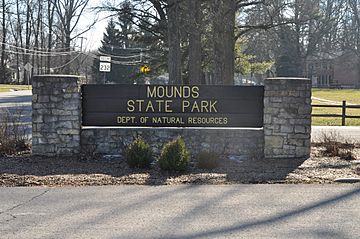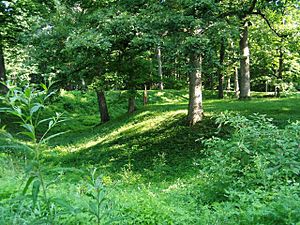Mounds State Park facts for kids

Mounds State Park entrance sign.
|
|
| Location | Anderson, Indiana, Madison County, Indiana, |
|---|---|
| Region | Madison County, Indiana |
| Coordinates | 40°6′1.39″N 85°37′14.60″W / 40.1003861°N 85.6207222°W |
| History | |
| Founded | 160 BCE |
| Cultures | Adena culture, Hopewell tradition |
| Site notes | |
| Architecture | |
| Architectural styles | earthworks |
| Architectural details | Number of monuments: 10 |
|
Mounds State Park
|
|
| Area | 251.8 acres (101.9 ha) |
| NRHP reference No. | 73000022 |
| Added to NRHP | January 18, 1973 |
| Responsible body: Indiana Department of Natural Resources | |
Mounds State Park is a special state park located near Anderson, Indiana. It's famous for its amazing Native American history. The park has ten ceremonial mounds. These mounds were built by an ancient group of people called the Adena culture. Later, another group, the Hopewell culture, also used these sites.
This park is different from the Mounds State Recreation Area. That other park is about 79 miles away, near Brookville, Indiana.
Contents
Ancient Earthworks and Mounds
The word "earthwork" means any structure made from earth. In Native American studies, there are three main types: mounds, circular enclosures, and complexes. You can find all of these at Mounds State Park. The park has a group of enclosures, some round and some rectangular. There are seven enclosures and four other earthworks. These are split into two groups: the northern and southern complexes. The "Great Mound" is the biggest structure in the park and part of the southern group.
The Great Mound: A Closer Look
The largest earthwork is called the "Great Mound." Experts believe it was built around 160 BCE. It's a huge circular area made of earth. It has a ditch on the inside and an entrance facing south or southwest.
The Great Mound measures about 394 feet across from one side to the other. Its tall wall, or embankment, is about 9 feet high and 63 feet wide at its base. The ditch inside is about 10.5 feet deep and 60 feet wide at the top. In the center, there's a flat area called a platform, which is 138 feet across. On this platform, there was a smaller mound about 4 feet high and 30 feet wide.
When archaeologists dug into the central mound in 1968 and 1969, they found three layers of clay. Each layer had ashes, which suggests the mound was used many times over a long period.
Dating the Mounds
Scientists used a method called radiocarbon dating to figure out how old the mounds are. They also looked at artifacts found there. The Great Mound complex was used between 160 BCE and 50 CE.
For example, a special pipe found nearby, called a platform pipe, looked like those made by the Hopewell people around 50 CE. Also, traces of old wooden posts were found and dated to 60 BCE and 230 CE. The embankment of the Great Mound itself was dated to about 160 BCE. Another mound nearby, called the "Fiddleback" Mound, was dated to about 120 BCE.
Images for kids





